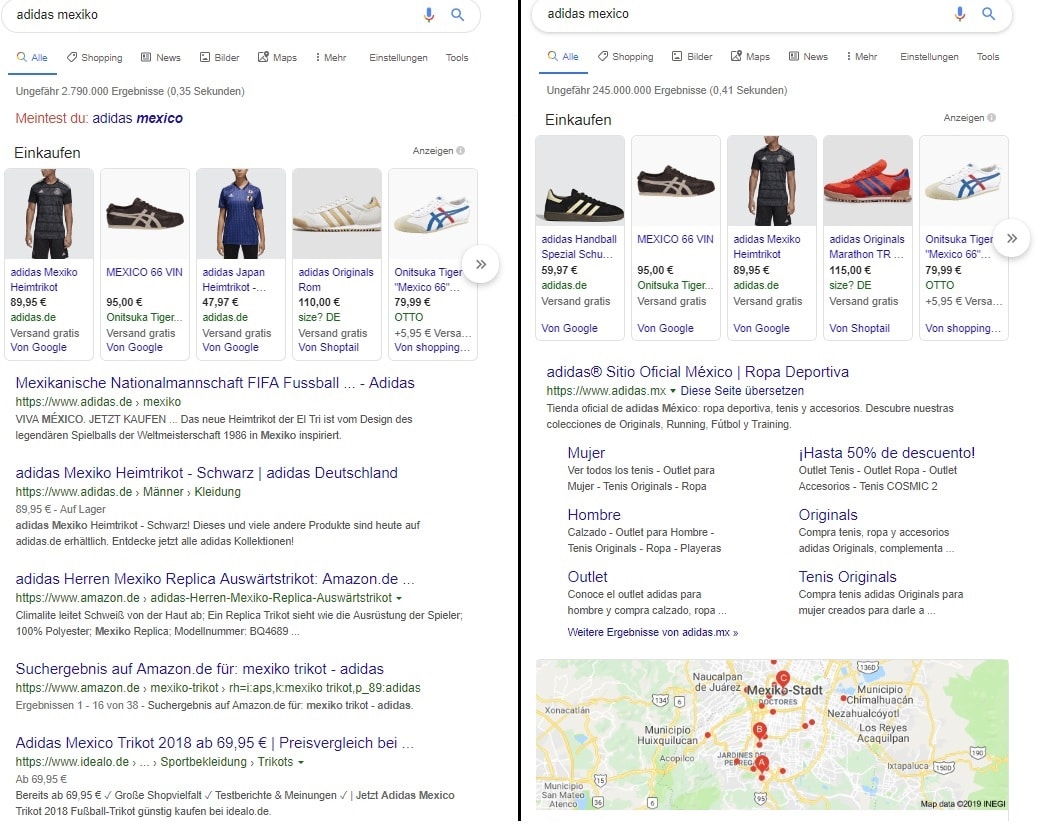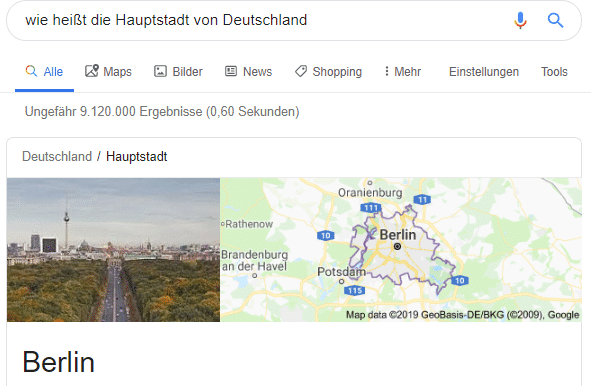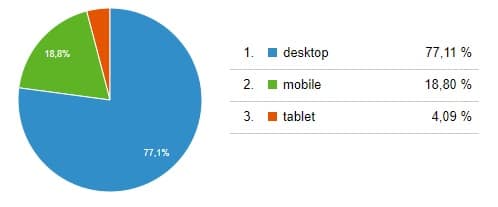Google Ranking Factors
“Google Ranking Factors – The Complete List!”
“SEO: The 37 most important ranking factors”
“The 10 most important ranking factors in Google!”
These are the first three answers I get when I search for “Google Ranking Factors” on Google.de. Most people and organisations that run websites are interested in their content being read frequently. It is therefore obvious to deal with the factors that positively influence search engine rankings. I do that again and again. But I have an individual perspective which I would like to describe to you. So if you are looking for the top 10 or the 37 most important ranking factors, or even need the complete list, you are better off with the other contributions. If you are interested in a classification of some important aspects and like repeated statements, then you have come to the right place.
Content is not King
People like to say, “Content is king.” Sounds good. But that’s only true to a limited extent, because the searcher is King. The searcher is a potential reader, website visitor, prospective customer or client – you can call him what you want. You can prescribe him in a sales funnel and try to make him a client step by step. Content ideally delivers the information that answers a search query. Content is therefore a means to an end. Without answering the intention of the searcher, content is simply text. Or graphics, video, audio. If you produce content, you should therefore be aware of three areas:
- Who would you like to address with your website and your content? Why do you want that?
- What do you want to achieve with the content? What do you want to communicate and why is it important for you?
- How can you best communicate “What” and “Why”?
This is the first area: you. With your wishes, ideas, goals and possibilities. The second area is the searcher:
- What does the reader want? What information is he looking for?
- What kind of content does your reader want to use? Does he want to read a short summary or a longer version? Does he want both? Is he interested in a video, would he like to hear the findings as a podcast or take the content with him as a download?
The third area is often overlooked:
- What situation is the searcher in? What is his context?
- What does the searcher really want to know at the moment of his search?
- How can you support the user in his context?
Why is the third area so interesting? Because the answer is essential for your content. Example: How often have you read an article with 2,000 words on your mobile phone? Probably not so often. As a car driver, would you prefer to read 2,000 words on your mobile phone or listen to them as a podcast? The situation in which the searcher finds himself determines both the search intention and the type and scope of the “ideal” content.
In summary, three questions are important:
- What do you want?
- What does the searcher want?
- In what context is the searcher?
The search intention
The search intention is a very exciting topic. Google continuously tries to understand it better. You can easily understand this by making the same search query on your company computer, your mobile phone over the cellular network and your tablet PC at home on the sofa. Often you get different search results. Sometimes the order of the results varies, sometimes advertisements are displayed above the rankings. Sometimes videos, pictures or shopping tips are displayed prominently. Google interprets your search query. Among other things, this can be based on the devices you use, the location you are in, your previous search and click behaviour, etc.
A small example: I am looking for “adidas mexiko” because I am interested in a football shoe from “Adidas” with the name “Mexiko”. Google doesn’t recognise my intention 100% and therefore asks: “Did you mean: adidas mexico? Mexico with a “c”. (Mexico is spelled with a “k” instead a “c” in German.) The search results vary for both spellings.
Now imagine two more extensions of the example:
- I’m in Mexico City and I’m doing the same search on my cell phone. Am I suddenly interested in the next Adidas store where I could buy football boots?
- I am in Mexico City, using my mobile phone with the same search query. But it is 11:45 pm and all stores are closed. Am I rather interested in an online store than a real store?
Search intentions depend on the context of the searcher. Determining them is complicated. Not only for Google, but also for every content producer. It becomes interesting when it comes to evaluating the ranking factors, because they also depend on the context. Let’s take a look at a list of often mentioned ranking factors.
Ranking factors in the spotlight
The order in which I deal with Google ranking factors says nothing about the concrete meaning of the individual factors. That’s because I a) don’t know any order and b) don’t think there is one. Google’s search algorithms are a well-kept secret. In addition, for some time now the ranking has been generated by artificial intelligence – who is supposed to be able to define a ranking order?
Let’s go:
Dwell time
The length of stay is an indicator of quality. If you compare two websites with similar content and if you stay longer as a visitor on one side than on the other, the longer stay is ONE indication of possibly better quality. In short, dwell time is positive.
Another example: You stand in a queue at the box office and wait two minutes for your ticket. That’s probably not so great, but it’s okay. Would you wait two minutes online for a ticket? Would you invest two minutes to download on one page? In such a case, the length of stay should be ONE indication of poor quality. In short: dwell time does not always have to be positive. A metric that, for example, calculates the average duration of visits on your websites is therefore relatively pointless. Increasing the time spent on a specific website could be a sensible goal.
ERGO: it depends on the CONTEXT.
Number of page views per session
It is easy to imagine that the number of page views per session is a good indicator of quality. They are interested in information, find similar or further information nearby and look at it as well. A high number of page views per session is therefore relevant. Is it more relevant than the time spent on one side or is it just looking at the other side of the medal? And is the number strongly dependent on the content of your website? Probably.
An example: You run a news portal and the reader is interested in the American president. He finds several articles and reads one or the other of them in whole or in part; the number of page views increases and that’s positive.
Another example: You have a website that describes how use cases work. The page explains the concept, types, benefits, advantages, etc. What should the reader look at when he finds “everything” about the topic on a page? In practice, this often results in content being “artificially” distributed across multiple pages; this increases the number of page views (while reducing the time spent on the individual page at the same time), but – provided the page is clearly laid out and easy to read – offers no advantage to the prospective customer and can even “annoy”.
Interestingly, the number of page views per session often correlates with the type of traffic: organic searches, direct views and social media views often have similar values. Paid search and referral traffic usually have lower values.
ERGO: the number of page views per session CAN be an indicator of relevant content.
Returning website visitors
The returning website visitor does not appear in many discussions about ranking factors. This is surprising from my point of view, because a visitor actually visits you again because he finds something that helps or pleases him. The more often he comes back, the better. Just like in real life: a regular guest is a good customer. He likes your business, your offer, the ambience. It’s the same in the online world. So the question is: what can you do to make the visitor visit your pages again? Possible answers are: You can, for example, use a newsletter (if you have permission to send him one) to draw his attention to new content and its relevance. Or you can inform your network about innovations, e.g. via social media such as Twitter, LinkedIN, Facebook.
ERGO: try to HIGHEN the number of returning visitors.
Number of words / length of content
There are many myths about the number of words. To put it in a nutshell: it can at best have a disorderly relevance. And this is due to the search intention. Example: “What is the capital of Germany called? How many words do you need to answer this question? One? “Berlin.” A sentence? “The capital of Germany is Berlin.” What do 2,000 words bring in answer to such a question? Nothing. Apart from that, Google will answer the question itself and you probably won’t be able to direct a visitor to your website.
ERGO: Focus on actual ranking factors.
Keyword
The handling of keywords is one of the most important ranking factors, especially since it corresponds to many other factors:
- Keyword density is the ratio of the number of keywords to the number of words in a text. Recommendations often speak of four or five percent, but beware: all absolute recommendations should always be treated with caution. If the keyword appears too frequently in the text, this is called keyword stuffing.
- Keyword stuffing is negative. Negative from Google’s point of view, but above all negative from the reader’s point of view. If you are interested in Use Cases, do you want to read the keyword “Use Case” in every second sentence, or do you like some variety better and you also understand the use of synonyms? For Google, the use of synonyms is part of holistic texts that broaden the scope a bit. This is interesting for Google and for the reader. And: if you look at the words for which a single page is ranked, you will be amazed at how often synonyms bring visitors to your website.
ERGO: Write your texts for people and not for Google and DO NOT exaggerate with the frequency of your keywords. - The keyword prominence deals with the position of the keyword. It says that the earlier the keyword appears in the text, the better it is. Example: “Stakeholders are people who …” is better than “people who …, are called stakeholders.” For most readers it makes no difference whether it makes a difference for the Google ranking, is difficult to judge, but prominence can not harm.
- The keyword in the title tag is definitely a good signal and should be used accordingly. Probably it also makes sense to place it as far in front as possible in the title of the page.
- Placing the keyword in the URL is essential. It is often speculated that both the position and the depth of the directory are criteria. For the position – the further up the better – the same should apply as for the title tag. The directory depth, however, depends on the structure of your website. Organizationally, for example, “the definition of stakeholders” does not belong on the same level as the services of your company. Since it can also be heard that Google is increasingly promoting clusters (as collection points for topics navigated to from the cluster), you should rather pay attention to a “logical” structure than positioning individual websites “too high”.
ERGO: The clearer and more comprehensible your website structure is, the better it is for Google AND your visitors. - The keyword must also appear in the metatext. The metatext itself is not a ranking factor, but serves the reader either as a source for a quick answer or as an ” appetiser ” that initiates his visit. It is advisable to check from time to time what the recommended length for metatexts is. At the moment it should be between 145 and 160 characters. If your metatexts are longer, Google will cut them and label them “…”.
It is interesting to note that Google displays content from the website as metatext if required, which you have not entered as metatext. Google interprets the contents of your website and delivers the metatext matching the search query. Thus, the use of synonyms also makes sense.
ERGO: Metatext is NOT a ranking factor, but it does influence the so-called Click Through Rate (CTR) of the searcher. - The keyword should also appear in the H1 tag. The H1 tag is the headline of your article (please use only one H1 per page, because Google is a machine and how would the machine know which H1 would be more important if you used more than one?). Here you can find a free HTML Headings Checker.
- The keyword can also appear in H2 or H3 tags, but it should make sense for the reader. You can neglect this as a ranking factor.
Duplicate Content
You should avoid identical content on your website at all costs. There are a number of reasons that lead to so-called duplicate content. For example, double content can occur if your website is accessible with and without “www” or with “http” and “https”. Your webmaster should be able to fix this quickly.
Duplicate content always appears “internally” (i.e. on your website) and/or “externally” (on other websites). Terms that are often used here are double onsite content, scraped content and syndicated content. Here is a small selection of things you should avoid because they have a NEGATIVE influence on your ranking:
- Identical websites that can be reached within your domain using different URLs. What should Google do with identical websites and what do website visitors think if they notice this?
- Identical or similar texts located on different websites (with different URLs). Since similar texts on different pages cannot always be completely avoided (e.g. product overview pages and the respective product pages), you should think about synonyms and rewriting texts. The use of “Text Spinning” or “Article Spinning” tools could also be useful.¹
- Scraped content is information that is copied from external sites – more or less unchanged – and presented as own content. This is a copyright infringement and Google could punish the “thief”. In fact, most job portals, for example, copy job ads from websites without any permission, but there doesn’t seem to be any punishments from Google. Theoretically, these portals could use a so-called Canonical tag to tell Google on which website the original text is located, but my personal tests didn’t show this. Basically you should not take any risks and use this tag if you publish blog posts that have already been published elsewhere. It is also a good idea to make this public to your readers. This is fair, correct and transparent.
Opinions on Syndicated Content vary. Content Syndication² is the term used to describe the publication of content on third-party websites, e.g. the publication of press releases in press portals or blog posts on platforms such as LinkedIN or Medium. Syndicated content is duplicated content, there are probably no two opinions. But: With LinkedIN and Co. you can set whether texts should also be searchable outside the platforms – i.e. in Google or in other search engines. So it could be duplicated content that is not disadvantageous. But CAUTION: this is only a personal assumption.
URL
Keywords in the URL are an important ranking factor. The following aspects are more frequently discussed in relation to the URL:
- The length of the URL. I would neglect this topic, because nowadays very few people type in a URL manually. Internet users often follow links. Technically, even URLs with a length of 1,024 characters shouldn’t be a problem, but I’ve never tried that before.
- URL categories are not a ranking factor for downstream websites, but they help both Google and the reader to understand the structure of the website. A category is a kind of common denominator under which individual web pages live. In our blog, for example, “project management” or “software development” are categories. The individual blog posts will not rank better by category, but the category (in itself also a kind of cluster) could benefit from the well ranked blog posts as an overview page.
- Meaningful URLs are at best indirectly a ranking factor. A meaningful URL is, for example, “t2informatik.de/en/services/”; the searcher recognises at a glance what information he can expect. The opposite of a meaningful URL is a cryptic URL, e.g. “t2informatik.de/en/12a4e6z. A meaningful URL is the prerequisite for keywords in URLs. To list it as an independent ranking factor therefore makes relatively little sense and shows that the lists circulating on the Internet about Google ranking factors are not always particularly logical. Apart from that, meaningful URLs are also displayed in the snippet of search results.
Domain
Also with regard to the domain, there are always aspects that are discussed repeatedly. Here is a small selection:
- The Exact Match Domain (EMD) certainly has a considerable influence on the ranking of a specific domain. If you search for a term and a domain is congruent with your search query, the corresponding website will have an advantage. If, for example, you are looking for your company, your website should be listed first. Apart from the fact that this can also be a “brand factor” (you are looking for “Adidas” so ideally Adidas should appear first and thus before any sports shop selling Adidas articles), the practical relevance is limited. Unless you set up a new domain, you already have yours. And: if EMD were really so unbeatable, you could ignore everything you have read before and will read from now on. Lower value websites will lose positions sooner or later despite EMD.
- In my opinion, you can neglect the age of the domain because you cannot influence it. Of course, the age of a domain, but above all the image of a brand and the trust in a company have an influence on the ranking. However, it is also no guarantee for a future ranking.
- The authority and the trust, i.e. the trust in a domain, are also considered ranking factors. Both can, but need not, correspond to the age of the domain. Those who continuously improve their website, produce valuable content and regularly publish new content will increase their ranking. This increases authority and trust; both aspects are therefore more a consequence than a cause.
Links
Links are a comprehensive topic and also worth a further article. Here some aspects as a short overview:
- Internal links help the reader to find further information. They help Google to understand your website, cluster topics and view your content holistically. Use internal links, but only where it makes sense. Also pay attention to the number of links, unless it is a cluster page. If you have a text with 200 words and 20 links, this will not only seem strange to the reader.
- Use also external links, if you offer valuable information to the reader. If your content is good enough, the prospective customer will come back (“returning visitors”). Think of the reader and his search intention, especially as it is a signal of strength for Google.
- Backlinks are mentioned in many articles as Top 10, Top 5 or even Top 3 ranking factors. If other websites reference your content from their texts, then this is like a small award. Building up backlinks is and will remain an important topic in the future. But pay attention to the quality, because backlinks from less relevant sources are not advantageous; they correspond to a recommendation of someone from whom you do not want to be recommended.
- The position of the links says something about the weighting of the additional information. A link in the first sentence of a text is maximally important; however, it would also be more important than the following text. The position of the link influences the number and distribution of links as well as the so-called link juice. This link juice – sometimes also called Google Juice – corresponds to a value that you pass on to the linked website based on the website visited.
- Nofollow links offer readers the opportunity to find more information, but (probably) don’t pass on any link juice. Here the statements vary, especially since Google follows the links despite the Nofollow statement. Thus it is not clear whether they have an influence on the ranking.
- Broken links certainly have an impact on ranking, even if it is only a minor one. If a link does not work (anymore), this is a sign of poor quality or quality control. Here you will find a small tool to quickly identify the broken links on your website.
- Affiliate links do not positively influence the ranking, but if you have too many of them on a website, it could have a negative impact.
- Sponsored links are a new way to categorize links. In order to clearly structure your website, you should use this attribute to declare your links, provided it is a link for which you receive payment from the sponsor. The same applies to the “user generated content” attribute (ugc), which refers to content published in forums, for example. These two new attributes will make it easier for Google to understand your links. As always, it’s hard to know what will happen if you don’t use these attributes. But why shouldn’t you just do it?
- Links from press portals have no effect, they were even considered “unnatural” recommendations for several years. Meanwhile, it can be assumed that Google simply ignores them. An exception could be links of the German Press Agency (DPA), because these are actually read by journalists and possibly used as a source for amounts about your company. However, the DPA service is not free of charge and the effect would be indirect at best.
- Links from Wikipedia are often valuable for websites, but not in the sense of a link juice or a reputation gained through it, because Wikipedia does not inherit any values. Maybe the reader will become aware of your website and it would be worth it.
Loading Speed
The loading speed is of course a ranking factor. You can easily understand this in yourself: how long do you wait until a website is set up? Tools classify loading speeds very differently, but most of the time they will tell you that your website is too slow. Nevertheless, the tools provide valuable insights into where you or your webmaster can make technical improvements.
There is a difference in terms of loading speed and awareness of the company or domain. Loading speeds are also important for Apple or Adidas, but you as a visitor are probably willing to wait a second or two longer than a “less known” manufacturer. Many companies have earned this brand bonus. Interestingly enough, Apple’s website, for example, loads super fast and you can use this as a confirmation of the loading speed as a ranking factor.
Some recommendations and comments
You haven’t read anything about some Google Ranking factors such as Mobile First or Mobile Friendliness, SSL certificates or Sitemaps. There is a reason for this, because there are no two opinions: Nowadays, your website has to be responsive and easy to read on mobile devices. You can, of course, take a look at the specific traffic categorisation of your website and perhaps you will even notice that the mobile part of your website is not yet very large, but this will gradually change. So if you haven’t already done so, you might want to move your site today rather than tomorrow.
Also use an SSL certificate for your website, even if you don’t ask your visitors for any security-relevant data. An SSL certificate offers and conveys security. And of course every website has a sitemap.
I would like to give you some more tips:
- The expiration date and the history of a domain or even punishments of domain owners are always discussed. Simply pay for your domain a few years in advance, do not buy a domain that already had numerous previous owners and do not allow yourself to be punished under any circumstances.
- When you deal with keywords, you also think of so-called long tail keywords. Long tail keywords consist of several words, generate less traffic, but offer a perfect answer to a search query. Example: “Adidas Mexiko 70 Shopping”. If you operate an online shop and sell this shoe, you want to direct this searcher to your site.
- Even though meta descriptions are not ranking factors, you should take the time to create compact meta descriptions. Double meta descriptions – i.e. identical meta descriptions that appear on several pages – are therefore wasted opportunities.
- Consider the URL, Title Tag, H1 Tag and metatext as a common task and use your desired keyword in each element.
- The number of comments, likes or shares of texts are interpreted as social signals. Do not buy any signals, ratings or followers! Don’t try to trick readers or Google!
- Avoid keyword stuffing and especially tricks like white writing on a white background or small text that is hard for the human eye to read.
- Optimise your images and fill in the alt text. The image search is relatively prominent in Google and can easily bring you visitors.
- The use of a content delivery network is not a ranking factor, but can accelerate the delivery of images depending on the location of the searcher.
- The existence of a chat is also not a ranking factor, but can increase the time spent on a specific page. It is similar with videos. It is often said that YouTube would be the second largest search engine in the world; regardless of whether this is true or not, on YouTube other topics are often searched for compared to Google. Of course, you can offer videos, audio, graphics and chats, but not based on any article, but because it’s good and important for your visitors. However, you should verify this very precisely in advance, because it is easy to incur large expenses without these paying off later.
- Use redirects if something changes on your website. This makes it easier for Google and all other search engines and your visitor is not directly lost. Only redirect to information that actually serves interest.
- It is speculated whether the integration of Google Analytics for the evaluation of your traffic has an influence on the ranking. Forget that, it would be insane if Google did something like this.
- Of course references, contact possibilities, general terms and conditions, imprint, data protection etc. belong on your website. Not as ranking factors, but as information for your readers.
Finally, a small question: why should Google regularly crawl your website, find the latest content and rank it prominently? The answer is: because you regularly produce new, relevant content. Content with which you try to achieve your goals. And with which the searcher gets answers to his questions.
Happy Google!
Notes:
Google and the Internet continue to evolve. As a result, information ages relatively quickly. It is therefore advisable to always look for current sources. There is only a single shortcut to quickly increase your listing: money. With money (and Google Adwords) you can bring your website to the top for your keyword. Google declares this with a small “ad” hint, but for many searchers this is not important or they do not pay attention to it.
Would you like to share your experiences with me? SEO is not a science, I like to learn from your experiences and share my knowledge. There are certainly other topics like advertising, bounce rates, pop-ups, voice search, helpful tools or usability that we can discuss.
Links (in German only):
[1] Hier finden Sie Informationen über Article Spinning.
[2] Hier finden Sie Informationen über Syndicated Content.
Michael Schenkel has published more articles in the t2informatik Blog, including

Michael Schenkel
Head of Marketing, t2informatik GmbH
Michael Schenkel has a heart for marketing - so it is fitting that he is responsible for marketing at t2informatik. He likes to blog, likes a change of perspective and tries to offer useful information - e.g. here in the blog - at a time when there is a lot of talk about people's decreasing attention span. If you feel like it, arrange to meet him for a coffee and a piece of cake; he will certainly look forward to it!







